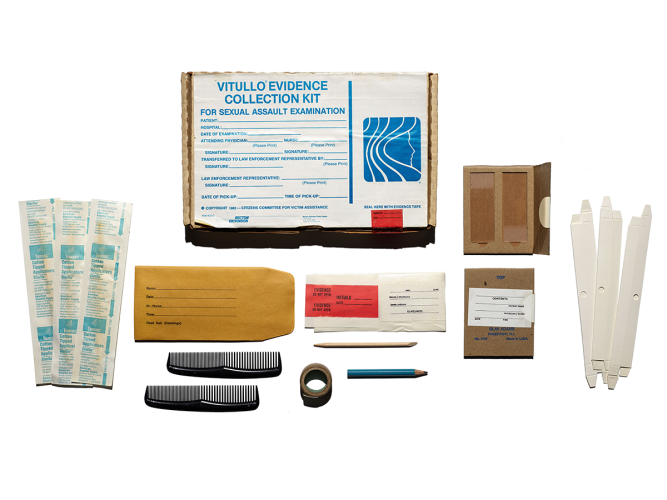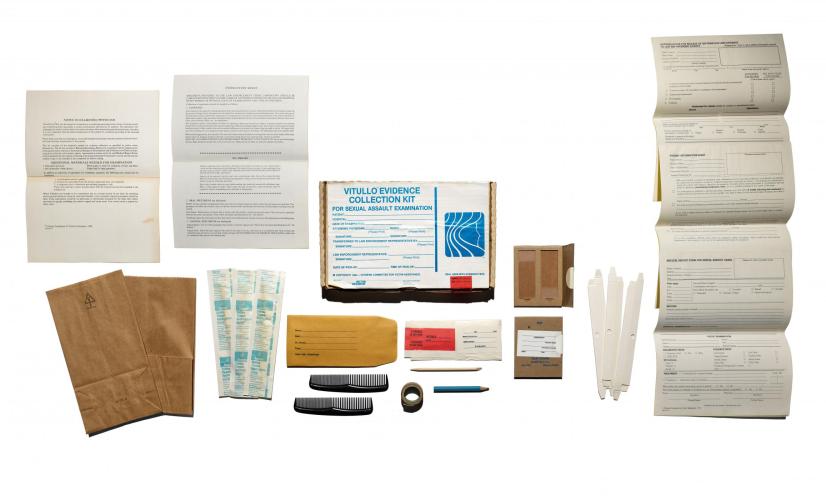
Vitullo Evidence Collection Kit for Sexual Assault Examination. Collection of the Smithsonian’s National Museum of American History and Cooper Hewitt, Smithsonian Design Museum. Museum purchase through the American Women's History Initiative Acquisitions Pool, administered by the Smithsonian American Women's History Initiative. Photo by Jaclyn Nash.
Today, the Smithsonian's National Museum of American History and Cooper Hewitt, Smithsonian Design Museum, announced they have acquired an early copy of the Vitullo Evidence Collection Kit for Sexual Assault Examination. The kit was designed between 1972 and 1978 by advocate Martha "Marty" Goddard. During this time, Goddard also worked as the founder of Citizens Committee for Victim Assistance in Chicago, Illinois.
Goddard created the sexual assault evidence kit because law enforcement had no standardized process to collect forensic evidence after a sexual assault. Through her work, she knew the police had been notified about tens of thousands of sexual assault cases that went unaddressed or unprosecuted because of a lack of admissable evidence.
The kit includes tools for evidence collection, such as labeled envelopes and bags for samples, swabs, paper bags to hold clothes, a comb, and more, as well as instructions. The kit includes a form where the survivor agrees that this evidence can be used by authorities, as well as treatment and counseling resources. The kits were easy to replicate and affordable. Today, kits like this one are used in hospitals across the United States as standard practice with survivors of all genders.

Vitullo Evidence Collection Kit for Sexual Assault Examination. Collection of the Smithsonian's National Museum of American History and Cooper Hewitt, Smithsonian Design Museum. Museum purchase through the American Women's History Initiative Acquisitions Pool, administered by the Smithsonian American Women's History Initiative. Photo by Jaclyn Nash.
She presented her design for a kit to Louis Vitullo, a Chicago police sergeant in the city's crime lab. Soon after the meeting, he introduced the "Vitullo Evidence Collection Kit for Sexual Assault Examination." Goddard advocated for the kit's implementation and worked to distribute it into the public safety system.
We asked four Smithsonian curators how this kit reflects American history.
Alexandra Cunningham Cameron, curator of contemporary design and Hintz Secretarial Scholar, Cooper Hewitt, Smithsonian Design Museum:
Marty Goddard's Evidence Collection Kit is a moving example of a designed response to an urgent issue. She relied on her experience as an advocate, rather than any formal design training, to devise a new system for addressing the crisis of under-prosecuted sexual assault in Chicago during the 1970s. Goddard designed with rather than for, engaging in a collaborative process of research and development that involved interviewing survivors, policy makers, law enforcement agents, attorneys, and hospital workers to understand how survivors were treated physically and emotionally, and how evidence was collected and used to prosecute cases.
The resulting kit is a powerful tool of intervention made with humble materials, mostly familiar "off the shelf" products like a paper bag and cotton swabs that are transformed when packaged together with a set of instructions. Goddard used the resources at her disposal to create a kit that was affordable to produce and straightforward to use, increasing the probability that it would be adopted. This kit is a complex and confrontational object tied to an enduring history of abuse. It elicits a wide range of reactions—pain, admiration, embarrassment, shame, regret, catharsis—and presents an opportunity to examine and process those feelings. At their best, museums create space for this type of reflection and inquiry. They can inspire audiences to try to address challenges they or their communities are facing.
Ashleigh Coren, women's history content and interpretation curator, National Portrait Gallery and acting head of education, Smithsonian American Women's History Initiative:
Smithsonian museums and centers house collections that enable interpreters and educators to shepherd our mission, which is to increase and diffuse knowledge. The evidence collection kit can help us tell stories in connection with the evolution of the collection and processing of forensic evidence, the history of social movements and grassroots organizations, and the issue of sexual violence against all genders.
These Smithsonian objects and exhibitions help audiences gain a richer understanding of how different people have considered this topic:
-
Suzanne Lacy's 1972 artist's book, Rape Is, in the Archives of American Art. Lacy's artist's book centers the testimonies of sexual assault survivors and was produced at Women's Design Program at California Institute of the Arts.
-
The National Museum of American History's collection includes objects, such as this pin, created in reaction to educational amendment Title IX, which also addresses collegiate sexual harassment and sexual violence.
-
Dr. Ntozake Shange's 1981 booklet of poems, Some Men, from the National Museum of African American History and Culture. Shange's poetry addresses violence towards women.
-
Devin Allen's 2015 photograph of a transgender rights march from the National Museum of African American History that brings a spotlight to transgender people to be victims of violent crime.
-
The National Museum of the American Indian's outdoor instillation of the REDress Project, an art piece by Jamie Black (Metis) that amplifies the issue of missing or murdered Indigenous women.
This new acquisition can bring dialogue and push learners to think critically about complex global challenges.
The REDress Project, an outdoor art installation by artist Jaime Black (Métis), features empty red dresses. Black hopes to draw attention to the gendered and racialized nature of violent crimes against Native women and to evoke a presence through the marking of absence.
Katherine Ott, curator in the Division of Science and Medicine at the Smithsonian's National Museum of American History:
The sexual assault evidence kit is a generative and emotionally intense object. It connects histories of 1970s and 80s feminist activism and their #MeToo inheritors today, as well as law enforcement, forensic science, and legal processes. It is grounded in complex inequities related to race, income, disability, gender, and age. The kit pushes us to explore questions about how this country has understood trauma by creating women's shelters and crisis hotlines as well as how our collective failures were deepened through oppressive structures such as enslavement, federal American Indian reservations, incarceration, and institutionalization.
The kit unsettles me. In sorting its entanglements, the historian in me is grateful to have it in our collections because it gives us a material way to explain the deep roots of the acceptance of violence and destructive gender relations. "Knowing" is strong medicine for healing. "Understanding" can help to undo the media silence and lack of public action that so frequently accompanies sexual violence—what many scholars and activists have identified as unchecked "rape culture."
Angela Tate, curator of women's history at the Smithsonian National Museum of African American History and Culture:
Many audiences turn to museums to interpret, discuss, and lead the conversation on difficult subjects. And many of us trust museums, and those responsible for collecting and conserving history and culture, with providing the expertise and context, the language, and the safety to encounter highly charged topics. At museums, we also hold a myriad of stories told and untold, and of people sung and unsung, who have shaped much of our contemporary understandings of the past—be it 200 or 20 years ago.
The story of Goddard and her role in the development of the sexual assault evidence kit represent both. Smithsonian staff collected this kit not to shock audiences, but to interpret the story of a woman activist and how her work as a victims' advocate—specifically around sexual assault—continues to influence conversations around the topic today.
This kit is a prism through which one can explore histories of law, feminism, policing, class, women's grassroots activism, and 1970s urban life. We can also use the kit to reflect on how these histories have developed since Goddard's creation of the sexual assault evidence kit.
Related Posts
Support for the acquisition of the sexual assault evidence kit was provided through the American Women's History Initiative Acquisitions Pool, administered by the Smithsonian American Women's History Initiative.